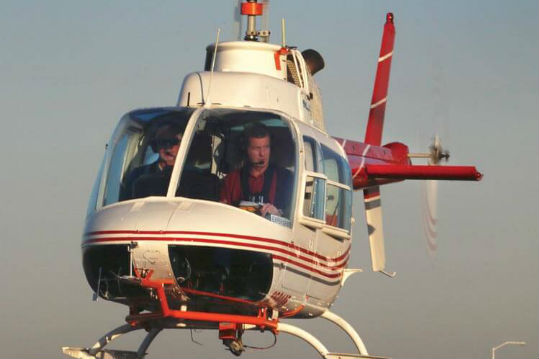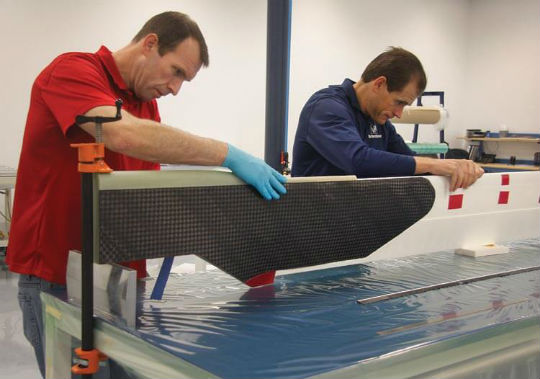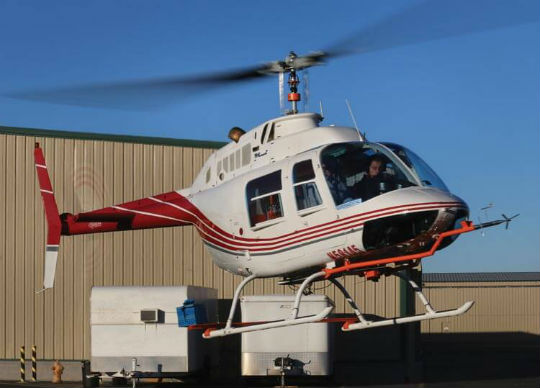
Van Horn Aviation’s test platform Bell 206 performs flight testing of the company’s composite 206 main rotor blades with a full complement of onboard specialized testing equipment. Photos by Kim Rosenlo
From its early beginnings as an offshoot of the U.S. Army’s Light Observation Helicopter program in the 1960s, to the end of its production in 2010, the Bell 206 JetRanger proved itself a reliable, efficient and safe platform for countless operators. The success of the design is evidenced in the thousands still in operation around the world. This not only provides a sizeable market for those offering support for the legacy aircraft, but also a big opportunity for inventive and innovative companies who can find new ways to improve the aging design.
One such company is Tempe, Ariz.-based Van Horn Aviation (VHA), which scored a great success in the Bell 206 market with its composite tail rotor blades—and is now following that up with its much-anticipated composite main rotor blades. Ahead of the blades’ release, VHA president Jim Van Horn and general manager Dean Rosenlof invited me down to Arizona to find out for myself how they flew.
Van Horn set the stage for my flight by saying a detailed discussion of the blade’s design and the results of performance tests would wait until afterwards. “I want you to go out and fly them—and I don’t want you to have any pre-conceived opinions,” he told me. That said, he advised me to pay attention to the control inputs and the amounts required for the desired action—and with that, experimental test pilot Greg Ashe and I made our way to the test ship.
Visually, the blades are quite stunning; they have a laminar flow airfoil shape, tapered tips, and flawless carbon fiber construction, with weight and dimensions closely mirroring the original blades. When static upon the rotor mast, there is little perceivable droop from the blade’s root to its tip—an indication of its stiffness. But function is also present in the design; composite blades need to be grounded to protect against potential lightning strikes, and instead of using grounding cable, the VHA blade continues a stainless steel abrasion strip along its leading edge to the front of the blade root, putting it in contact with the rotor head grips.
One would expect that with the laminar flow design and new composite materials, the VHA blades would behave differently from those of the original aircraft. They do somewhat—but in pleasantly unexpected ways.
Putting the blades to the test
On start and ground run of the test aircraft, familiarity prevailed, but upon lifting to a hover, there was a noticeable smoothness in the feeling the blades transmitted through the airframe. The transition into translational lift was similarly smooth, and upon maneuvering the aircraft in flight, there was a definite reduction in the amount of cyclic input required; the aircraft actually felt much like the responsive modern European aircraft control system that I currently fly.
It is important to note that in regards to blade track and balance, I am making what I believe are honest comparisons to the standard Bell 206 blades, having spent considerable time with the aircraft as both a pilot and airframe and powerplant (A&P) mechanic. The standard Bell 206 blades that I am accustomed to flying are tracked and balanced to the comparably high standard of VHA’s test platform aircraft.
During my test flight of the VHA system, I put the aircraft through a series of maneuvers ranging from basic straight and level flight, controlled descents, climbs and shallow banks and turns, and graduated towards more aggressive G-loaded turns, descents and other maneuvers including settling with power and simulated hydraulic control failure. With the reduced cyclic control input requirements, flight in simulated hydraulic failure appeared easier in terms of physical demand and ease of control.
In non-standard maneuvers such as ag-turns (return to target), the aircraft performed to a high standard. There was also a noticeable reduction in the noise signature of the blades—still the familiar 206 “wop,” just quieter and softer (which would be a definite benefit in noise sensitive areas).

VHA test pilot Greg Ashe (left) and VHA president Jim Van Horn are a dynamic and successful team during flight test, and their combined experience has lead to high levels of efficiency.
Design and test
For VHA, the composite 206 main blade project has spanned three years of development and testing. The blade design is a shell construction with a highly loaded surface. It employs a thick carbon fiber skin over a structural foam core that basically acts as a flying mandrel—a design that has a proven history of serviceability and dependability.
Van Horn said the design sought to strike a balance between how smooth VHA could make the blade and how much control load they will allow to occur. “These two parameters in the blade—smoothness and control load—are counter to each other; a blade with very little control load is not as smooth as one with high control loads, but by the very same token, you can only stand so much control load.” Adjustments such as moving the blade’s center of gravity (CG) forward during testing allowed the team to aim for stability.
But a good rotor blade is only half of the equation; VHA’s engineers also needed to look at the control systems. The original Bell blade design was tuned using masses, such as lead and brass for inertia, and modal correction to smooth the blade’s performance.
The VHA blade involves a different airfoil design, stiffness, materials and control loads; these differences had to then be integrated with the existing Bell 206 hub. Its ability to structurally integrate with VHA’s modern composite blade is an area of focus in the VHA test protocols. “It is not possible to just plug and play, and that is why we are re-qualifying the entire 206 hub and control system to accommodate the different load spectrum that the VHA composite blade introduces into the helicopter,” Van Horn explained.
The rules that govern standard category aircraft certification in the U.S. are laid out in Title 14 of the Code of Federal Regulations, part 27. The key for manufacturers is in understanding what constitutes compliance. VHA worked closely with the Federal Aviation Administration (FAA) to determine which paragraphs applied to their blades, and how to meet the requirements as a manufacturer. After the two parties agreed on a series of tests and design functions, VHA set to work on completing testing and submitting reports. “The key is to do what you say you are going to do,” said Van Horn, who works hard to maintain a positive relationship with the FAA. “As soon as you try to skirt the regulations as a manufacturer, you become a non-complier.”
In their Tempe facility, VHA designed and built a test jig in which blade and control system stress and fatigue testing could be conducted. The jig used to perform the 800-hour tests on the blades consisted of a massive rugged steel framework, so that all flexing and torsional movements were transmitted directly to the rotor blade and hub being tested. Strain gauges bonded to critical areas on the blade, hub and other components, precisely measured the strain experienced at those locations. This provided highly accurate data as to the blade and rotor head test performance, which is used in the certification process and to determine blade life during operation.
When it came to flight test time, the vast experience of test pilot Ashe came to the fore. A former Boeing and McDonnell Douglas test pilot, Ashe is able to notice anomalies very quickly, leading to saving time through avoiding the unnecessary testing of a potentially flawed model. “The key is to listen,” he said. “Helicopters will talk to you before things start going wrong.”
While the majority of VHA’s flight tests were conducted in Mesa, Ariz., Van Horn and Ashe travelled to Leadville, Colo., the highest airport in the United States; and Flagstaff, Ariz., to verify blade performance at various altitudes. “For hover performance, tethered hover tests are performed to establish the weights, which you can hover with HOGE [hover out of ground effect] and HIGE [hover in ground effect] in specific atmospheric conditions,” explained Van Horn. To get these values required multiple power inputs, and the data was measured with a load cell attached to the hook. “With an experienced test pilot, you can perform a 15-point test in 30 seconds, which allows you to collect data on an entire sweep of power versus thrust,” Van Horn added.
Performance verification testing is hard to do correctly, and very minor changes can have a big impact. “It’s a bit of a dichotomy, because we must fly the verification tests to degrees of accuracy generally unobtainable by the operational pilot,” said Van Horn.

Jim Van Horn and Dean Rosenlof add initial plies to a main rotor test blade.
The mindset
Accuracy of the model matters to VHA, and it is unwilling to assume that any load margins are insignificant. This is where the company’s genuine love of testing factors in. “You have to be a believer in test to be successful, and many small companies aren’t because it is so expensive,” said Van Horn. “With VHA, you have a collection of highly intelligent and motivated people who love to test and are committed to the success of their products.”
VHA is not timid in its approach. Its business model is to double the lifespan of the original product at a minimum premium with superior product support. There is great value in that.
At the time of Vertical’s visit to Tempe, VHA’s main rotor blades had completed flight testing and received type inspection authorization from the FAA. VHA is estimating an initial production of two sets of blades per month, and expects to be able to ramp up to full market demand in 18 months. It will be announcing pricing in Louisville, Ky., at HAI Heli-Expo 2016—but said the blades have been designed and priced so that everyone can benefit from them.
As Vertical went to press, VHA was expecting to receive a supplemental type certificate for the blades by the start of 2016.





